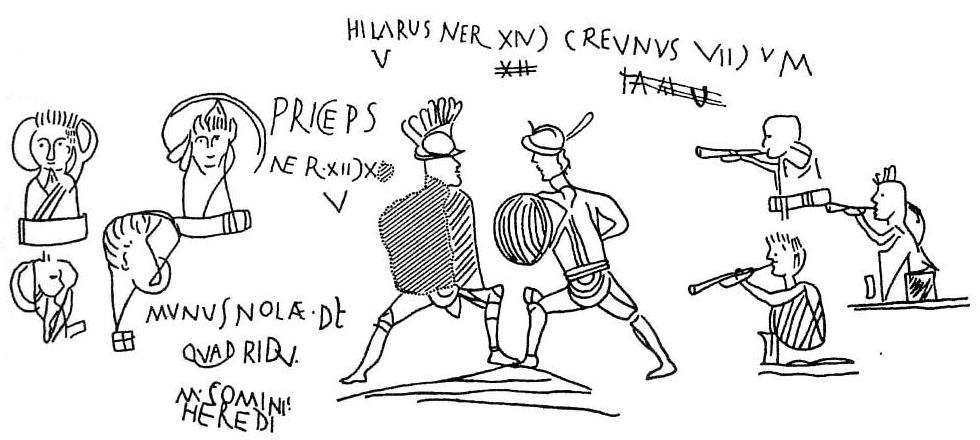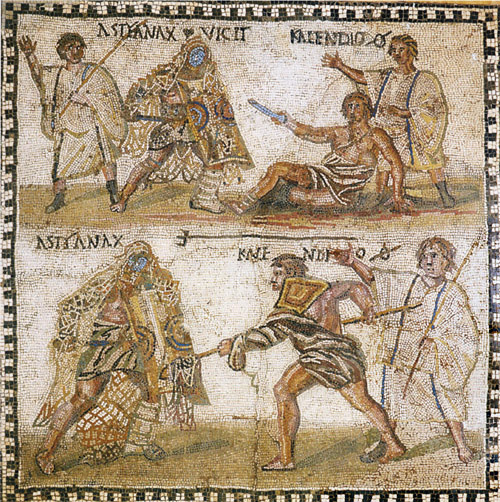Gladiators
Marketing and Advertising
In this section you will learn
- how the Romans advertised gladiatorial shows
- what information advertisements for such events shows and thought was important
- gladiatorial programs
Once you’d hired your gladiators and venatores, you had to advertise them. Various public notices were put up to ensure that people not only knew of munera but who was sponsoring them, from what ludus the gladiators were trained in, and what could be expected in terms of numbers and facilities (in a hot climate like Italy, awnings were very welcome and feature in many of these advertisements). There were also handbooks one could obtain listing further details of wins and losses: these, unfortunately, do not survive. However, because of the eruption of Vesuvius in 79 CE, we have several posters (or, rather, hand written notices) advertising shows in Pompeii.

The above graffiti comes from Pompeii and advertises a munus in the nearby town of Nola. The image shows a Thracian with small shield (right) fighting a secutor, the usual pairing for these gladiators. The text says
At Nola there will be a munus of Marcus Cominius Heres for four days. Princeps of the Neronian ludus fought 13, 10 wins; Hilarius of the Neronian ludus fought 14, 12 victories, Creunus fought 7, 5 wins.
CIL 4.10237
The following announcements are also from Pompeii and advertise a range of munera. Many of the editors (givers of the games) are mentioned in multiple advertisements and were clearly leading residents of the city:
The gladiatorial familia of the aedile Aulius Suettius Certus will fight at Pompeii on May 31. There will be a venatio, and also awnings.
CIL 4.1189
The gladiatorial familia of Aulus Suettius Certus will fight at Pompeii on May 31. There will be a venatio and also awnings. May Nero be happy in all his munera.
CIL 4.1190
Twenty pairs of gladiators provided by Decimus Lucretius Satrius Valens perpetual priest of Nero, the son of the Emperor, and ten pairs of gladiators provided by Decimus Lucretius Valens his son, will fight at Pompeii April 8, 9, 10, 11, and 12. There will be a big venatio and awnings. Aemilius Celer wrote this by the light of the moon.
CIL 4.7795
There will be a venatio and 20 pairs of gladiators belonging to Marcus Tullius will fight at Pompeii, November 4-7.
CIL IV. 3.4 9979
Aulus Clodius Flaccus, son of Aulus, Tribe Menenia,[1] duovir three times (once as Quinquennial), military tribune elected by the People. He presented at the Ludi Appollinares during his first duovirate in the Forum a procession, bulls, bullfighters and their helpers,[2] three pairs of platform fighting gladiators[3], boxers in groups, and games with music and pantomimes and Pylades,[4] and gave 10,000 sesterces to the public during his duumvirate. In his second (Quinquennial) term, at the Ludi Appollinares in the Forum he presented a procession, bullfighters and their helpers, and group boxers; on the next day he exhibited on his own at the spectacles 30 pairs of athletes, 5 pairs of gladiators, and with his colleague he presented 25 pairs of gladiators and the venationes, bullfighting, bull-baiting, wild boars, bears, and other wild animals in various hunts. In his third term along with his colleague he presented games [or dramas] from a foremost group with added music.
CIL 10.1074d
Some posters advertised munera in nearby towns:
Twenty pairs of gladiators provided by Quintus Monnius Rufus will fight. Nola May 1st, 2nd, 3rd. There will be a venatio.
CIL 4.3881.
Thirty six pairs of gladiators of Constantia (?) will fight. October 31 and November 1-4 Nuceria (?).
CIL 4. 3.
Twenty pairs of Gladiators, belonging to Aulus Suettius Antenio and to his freedman Niger, will fight at Puteoli on the 17th, 18th, 19th and 20th of March. There will also be a venatio and athletic contests.
CIL 4. 3.4
We also know that there were programs for the games issued in advance as the following passages show. The first is Ovid’s guide to romance in ancient Rome:
While talking, touching hands, checking the program, and asking which one will win after he’s placed his bed, he groans from his wound as he feels the flying arrow and becomes a part of the show he’s watching.
Ovid, Art of Love, 1.167-171
The philosopher Seneca the Younger, who lived during the era of Nero (he was actually his tutor), mentions programs in several passages:
No man who is desperately running to get a midwife for his daughter in her birth-pangs will stop to read a praetor‘s edict or the order of events at the games.
Seneca the Younger, Letters 117.30
And so they strive for something else to occupy them, and all the intervening time is irksome; exactly as they do when a gladiatorial exhibition is announced, or when they are waiting for the appointed time of some other show or amusement, they want to skip over the days that lie between.
Seneca the Younger, On the Shortness of Life 16.3
The programs contained pairings and the names of individual gladiators as the following very late source shows:
For Gallus Antipater, the slave of honours and the dishonour of historians, composed a preface about Aureolus which began like this: “We have now come to an emperor who was like his own name.” A marvelous thing, for sure, to get one’s name from gold! I, however, know well that among gladiators this name has often been given to courageous fighters. Indeed, only recently your own announcement of games contained in the list of the combatants this name.
Historia Augusta, Claudius Gothicus 5
This graffiti from Pompeii (CIL IV 2508) may resemble the information that was given on such programs, giving the names of the fighters, the pairings, and the ludus they trained at:
? versus Hoplomachus
(missio) …ciens Neronian ludus, 20 [bouts]
(won) Nobilior, Julian ludus, 2….14
Thracian versus Murmillo
(won) Pugnax, Neronian ludus, 3 [bouts]
(died) Murranus, Neronian ludus, 3 [bouts]
Hoplomachus versus Thracian
(won) Cycnus of the Julian ludus 9 [bouts]
(missio) Atticus, Julian ludus 14 [bouts]
Thracian versus Murmillo
(won) Herma, Julian ludus, 4 [bouts]
(missio) Quintus Petillus….
(missio) Publius Ostorius, 51 [bouts]
(won) Scylax, Julian ludus, 26 [bouts]
Thracian vs. Murmillo
(died) Lucius Fabius, 9 [bouts]
(won) Astus, Julian Ludus, 14 [bouts]

Media Attributions
- CIL IV 10237 is licensed under a Public Domain license
- Astyanax_vs_Kalendio_mosaic is licensed under a Public Domain license
- This inscription dates to before 3 BCE. ↵
- The word I have translated as helpers is succursores, which is of uncertain meaning, so it may refer to some other type of animal fighter. ↵
- The Latin refers to the gladiators as pontarii, which appears to refer to any gladiator who fought from a raised platform. ↵
- A famous mime artist; notice he is the only performer important enough to be mentioned by name. ↵
A trained beast hunter. Not to be confused with criminals who were thrown to the beasts as a form of execution; although fighting wild animals is never going to be a safe endeavour, these were trained professionals, who were armed. There was a ludus in Rome dedicated to training them, the Ludus Matutinus. Venatores were usually part of the morning show.
Literally “gift”, “duty”, or “favour”, particularly one owed to the dead. As gladiatorial shows were given to honour the dead and in accordance with vows they were called munera. A munus in this sense was a private obligation and thus the cost was paid by whoever vowed it, not the state. Later the munera were integrated into the other games and incorporated into imperial spectacles.
A ludus may refer to any type of school, including a gladiatorial one. Ludi also refers to games, the public games held as part of religious rituals.
A type of gladiator who fought with a small shield (called a parmula) and a curved, short sword.
Literally “follower”, a type of gladiator usually matched against a retiarius. He was armed very much like a murmillo, but had a different helmet with very little visibility from two small eyeholes, which was designed so the retiarius net could not catch easily and the trident was better deflected.
A sponsor of a ludus (i.e. whoever was paying for and hosting it).
The first rank on the cursus honorum, the course of public offices, these magistrates were in charge of maintaining public buildings and space and supervised and organized the public festivals. There were two types of aedile, curule, and plebeian.
Beast hunts, sometimes in staged settings. A wide range of domestic and exotic animals were hunted. Although dangerous, a venatio was not necessarily fatal for the hunters, who were given weapons and had some protection.
‘One of the two men’ (in plural ‘the two men’) is a term used for any dual magistracy. When used in reference to Italian towns and Roman colonies it refers to the chief magistrates (the local equivalent of the Roman consuls).
Mid-first century CE Roman Stoic philosopher, Lucius Annaeus Seneca was the son of Seneca the Elder. He was exiled under the Emperor Caligula for adultery, but recalled under Claudius to be tutor Nero. He wrote a number of philosophical works and philosophical letters to a young philosopher, Lucilius. He was also extremely wealthy - at one point the wealthiest private citizen in Rome. He committed suicide at the orders of Nero.
The second most senior position in the cursus honorum, there was originally only one, but the number expanded to 8 and then 16 as the needs of the administration demanded more and more magistrates.
A “shield-fighter”; the word is originally Greek. This gladiator carried a short round shield, a spear, and a dagger, which was adapted from Greek infantry equipment. He had a helmet and greaves as well.
Literally “a sending away”, it refers to the release of a gladiator at the end of a combat. Gladiators could be sent away stantes missi, that is, they were released from that particular munus after fighting to a standstill with no one clearly gaining the upper hand. There were rare games that were sine missione, where (possibly) every combat ended with one gladiator dying: under the empire you had to get imperial permission to have a munus of this type. (Some people argue that in these losing gladiators did not necessarily die, but that there had to be clear victors and losers.)
A heavily armed gladiator whose helmet had a decorative murmillo, a type of salt-water fish, on it. He had a large oblong shield behind which he crouched and used a gladius, a short thrusting sword.
A gladiator who fought from a British style war chariot. This type may have been introduced by Julius Caesar after his ‘conquest’ of the island.

